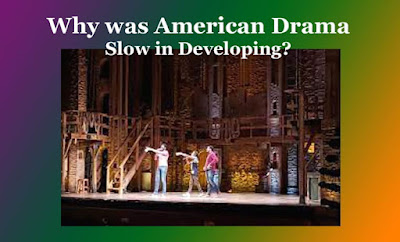Development of American Drama
Development of American Drama
Development of American Drama
Introduction:
The development of American drama has been a dynamic and multifaceted journey, evolving in response to changes in society, culture, and artistic movements. Spanning several centuries, American drama has transformed from its early roots to encompass a wide range of styles, themes, and voices. Here is an overview of the key stages in the development of American drama:
Development of American Drama - Key Stages
Colonial Period (17th-18th centuries):
Religious and Educational Drama: The earliest dramatic performances in colonial America were often religious or educational in nature. Puritan influences in New England suppressed theatrical activities, while in the southern colonies, performances were more lenient.
19th Century: Melodrama and Social Critique:
Melodrama Emerges: The 19th century saw the rise of melodrama, characterized by exaggerated emotions and moralistic themes. Playwrights like George L. Aiken and Anna Cora Mowatt contributed to this genre, appealing to a broad audience.
Social Critique: American playwrights began incorporating social critique into their works as the century progressed. Harriet Beecher Stowe's "Uncle Tom's Cabin" (1852) was adapted into a play, becoming a powerful tool for abolitionist movements.
Realism and Naturalism (late 19th-early 20th centuries):
Shift to Realism: Playwrights like Augustus Thomas and Clyde Fitch embraced realism, depicting everyday life and societal issues more accurately. This period also saw the influence of European playwrights like Henrik Ibsen on American drama.
Eugene O'Neill: Often regarded as America's greatest playwright, Eugene O'Neill emerged during this time, introducing psychological complexities and innovative techniques. Works like "Long Day's Journey Into Night" (1956) marked a departure from traditional theatrical forms.
The Harlem Renaissance (1920s-1930s):
African American Contributions: The Harlem Renaissance brought a flourishing of African American arts, including drama. Playwrights such as Langston Hughes and Zora Neale Hurston contributed to the development of African American theater, addressing racial and social issues.
Federal Theatre Project: Created during the Great Depression, the Federal Theatre Project (1935-1939) supported diverse voices, providing opportunities for experimentation and exploration of new themes.
Post-World War II: Theatrical Experimentation and Absurdism:
Off-Broadway Movement: After World War II, the Off-Broadway movement emerged, allowing for more experimental and avant-garde works. Playwrights like Tennessee Williams ("A Streetcar Named Desire," 1947) and Arthur Miller ("Death of a Salesman," 1949) explored the human condition and societal issues.
Absurdist Drama: The 1950s and 1960s witnessed the rise of Absurdist drama, influenced by European playwrights like Samuel Beckett. American playwrights like Edward Albee ("Who's Afraid of Virginia Woolf?" 1962) embraced this existential and often surreal style.
Contemporary Era (Late 20th Century-Present):
Diversity of Voices: The late 20th century and early 21st century saw an increasing diversity of voices in American drama. Playwrights like August Wilson, Tony Kushner, and Suzan-Lori Parks explored a wide range of themes, including race, identity, and social justice.
Experimental Theater: The contemporary era continues to witness experimental forms and styles, with playwrights like Sam Shepard and Caryl Churchill pushing the boundaries of traditional theatrical conventions.
Digital Age Impact: The advent of the digital age has influenced the way dramas are created, distributed, and consumed, with online platforms providing new opportunities for playwrights and theater-makers.
Conclusion:
In conclusion, the development of American drama reflects the nation's ever-evolving social, cultural, and political landscape. From its humble beginnings in the colonial period to the diverse and dynamic works of the contemporary era, American drama continues to be a vibrant and influential force in the global theatrical scene. The ongoing exploration of new forms, themes, and perspectives ensures that American drama remains a powerful medium for reflecting and challenging the complexities of human experience. 0 0 0. Development of American Drama
You May Like:










Comments
Post a Comment